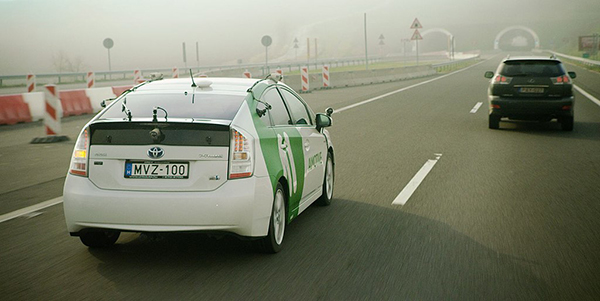
The influence of wheel wander on asphalt pavement design
The rate at which technological change occurs is rapid. Many predictions of technological progress show the rate as being exponential. According to Ray Kurzweil, an inventor and futurist, “We won’t experience 100 years of progress in the 21st century – it will be more like 20,000 years of progress.”
Automakers are experiencing unprecedented change as technological advancements continue to disrupt their industry. Autonomous driving technology is expected to have a profound impact on multiple industry sectors. There is some debate, though, on how it will impact the future of pavement design.
It is estimated that by 2030 nearly a quarter of all miles driven in the U.S. will be from autonomous vehicles (“AVs”) and that there will be 11 million AVs on the road globally, which translates to about 5 percent of the world’s traffic population. The Center for Automotive Research estimates that AVs could account for 55 percent of new-vehicle sales by 2040.
A question to be considered in preparation for the predicted AV revolution is: Should our roads be designed for AVs or should AVs be designed for our roads?
Wheel wander
The term ‘wander’ is used to describe the lateral distribution of wheel loads on the road. The randomness of wheel positioning within a lane is influenced by several factors, including lane width and operator driving patterns. The AASHTO Pavement Design Guide published in 1993 did not account for wander. However, it has been proven to be an important factor in pavement performance, particularly in the absence of it.
The Federal Highway Administration’s WesTrack pavement testing facility used AVs in the 1990s for research and field validation studies. The AVs were initially designed to operate with no wander. According to the article “Westrack: Putting ITS to Work”, if an AV truck operates with zero wander “the precise repeatability of the truck paths (less than 2 mm of variation) would reproduce the rain grooves of the tire tread in the asphalt.” The article states that concentrated wheel-path loading will accelerate the pavement wear and quickly establish rutting or fatigue cracking within the narrow wheel-loading area. Once the critical role of vehicle wander was realized, the WesTrack AVs were programmed with wander added to reproduce driver variation.
Today, flexible pavement design guides have been updated to take wander into account. The Pavement ME Design uses a default value of 10 inches for traffic wander standard deviation.
Another significant factor to consider is the relationship between loading and the magnitude of damage applied to the pavement. As the loading increases, the stress or damage to the pavement increases exponentially, roughly to the power of four. The damage applied by a typical passenger car is negligible compared to that of a heavy axle weight truck. Therefore, the commercial freight trucking industry’s conversion to using AV’s should be of substantial interest when considering the implications of heavy axle loading concentrated in narrow wheel paths.
Controlling wander
In a study to quantify the effects of truck wander on pavement performance, it was found that “the ability to methodically control wander by programming the AV positioning could extend the life of the pavement, thereby reducing the life cycle cost. Instead of programming wander to simulate normal Gaussian distribution of human drivers, a uniform distribution of loading across a wider range of the pavement surface was shown to reduce pavement damage. The incorporation of autonomous trucks, when programmed with uniform wander covering the entire width of the pavement, was found to improve overall performance or reduce the required pavement design thickness. (Noorvand et al.)”
On the opposite end of the spectrum, in the absence of wander some suggest road widths can be narrowed up to 25 percent with lane widths reduced to that of the widest AV. Using this model, roads would need to be designed to account for the channelized loading, resulting in increased pavement thickness. If the pavement is not designed for such loading, the damage could be “highly detrimental and noticeable at autonomous truck volumes as low as 10 percent (Noorvand et al.)”
Preparing for the future
Dr. Audrey Copeland, COO of the National Asphalt Pavement Association gave a presentation in June of 2018 on disruptive technologies in which she shared, “Asphalt pavement is well over 90 percent of the U.S. pavement infrastructure. The most cost-effective path to implementing vehicle technologies, such as AV’s, is to maintain this infrastructure.”
The AV revolution is not going to happen overnight, but the consensus is that we’re headed there, so we need to start preparing for it. Today’s pavement infrastructure was not designed for zero wander conditions. As new roads are built with a design life extending into the AV era, a default value of 10 inches for traffic wander may no longer be appropriate.
But adjusting pavement design isn’t the only option. Adjusting the AV wander is worth considering, especially if today’s existing pavement roads will be subjected to heavy AV’s.
Fee is a Lab Manager for Flint Hills Resources, LP in Minnesota.
References:
1. “Westrack: Putting ITS to Work” (1997) Ashmore, C. and Mitchell, T.
2. “Autonomous Vehicles: Assessment of the Implications of Truck Positioning on Flexible Pavement Performance and Design” (2017) Noorvand, H., Karnati, G. and Underwood, S.













